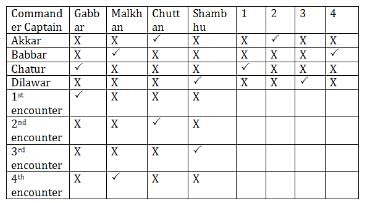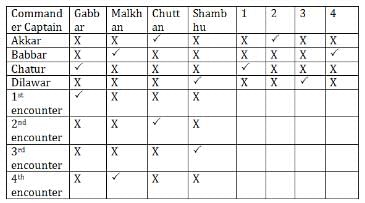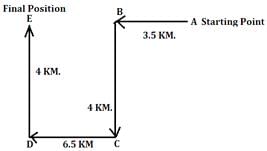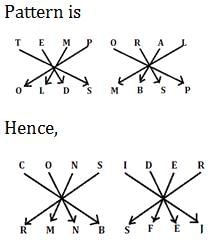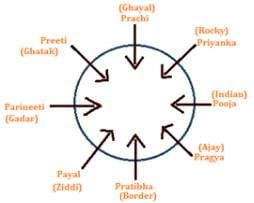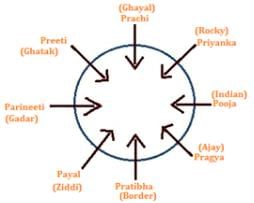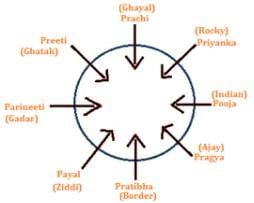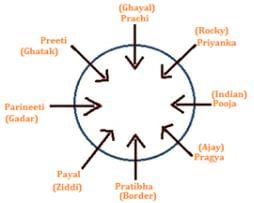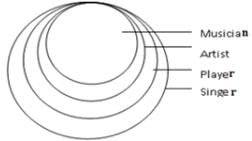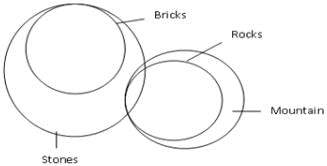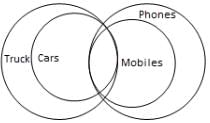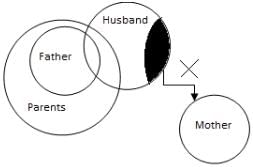NABARD Reasoning Practice : 3 - Bank Exams MCQ
30 Questions MCQ Test NABARD Assistant Manager Grade A Mock Test Series 2024 - NABARD Reasoning Practice : 3
Study the following information and answer the questions given.
In a certain code language “lu ja ka hu” means ‘we provide study material’,
“fa ka la ju” means ‘we score maximum selection’,
“la fu ja ju “ means “study score the selection”
and “ju lu na fu” means “selection of the material”. Then
Q. What is the code of “score “ in this code language?
“fa ka la ju” means ‘we score maximum selection’,
“la fu ja ju “ means “study score the selection”
and “ju lu na fu” means “selection of the material”. Then
Study the following information and answer the questions given.
In a certain code language “lu ja ka hu” means ‘we provide study material’,
“fa ka la ju” means ‘we score maximum selection’,
“la fu ja ju “ means “study score the selection”
and “ju lu na fu” means “selection of the material”. Then
Q. What is the code of “provide “ in this code language?
“fa ka la ju” means ‘we score maximum selection’,
“la fu ja ju “ means “study score the selection”
and “ju lu na fu” means “selection of the material”. Then
| 1 Crore+ students have signed up on EduRev. Have you? Download the App |
Study the following information and answer the questions given.
In a certain code language “lu ja ka hu” means ‘we provide study material’,
“fa ka la ju” means ‘we score maximum selection’,
“la fu ja ju “ means “study score the selection”
and “ju lu na fu” means “selection of the material”. Then
Q. What is the code of “ provide of maximum”?
“fa ka la ju” means ‘we score maximum selection’,
“la fu ja ju “ means “study score the selection”
and “ju lu na fu” means “selection of the material”. Then
Study the following information and answer the questions given.
In a certain code language “lu ja ka hu” means ‘we provide study material’,
“fa ka la ju” means ‘we score maximum selection’,
“la fu ja ju “ means “study score the selection”
and “ju lu na fu” means “selection of the material”. Then
Q. What is the code of “we the” in this code language?
Study the following information and answer the questions given.
In a certain code language “lu ja ka hu” means ‘we provide study material’,
“fa ka la ju” means ‘we score maximum selection’,
“la fu ja ju “ means “study score the selection”
and “ju lu na fu” means “selection of the material”. Then
Q. What is the code of ”material” in this code language?
These questions are based on the following information.
Five friends Neha, Naveen, Aashish, Ragni, and Nisha are from five different cities viz. Ahmadabad. Bangalore, Calcutta, Delhi and Ernakulam. They are experts in five different fields i.e. teaching, music, doctor, software engineering and fashion designing but not in same order.
1. Naveen is not from Bangalore.
2. Doctor is either from Delhi or Ahmadabad.
3. Nisha is from Ernakulam.
4. Ragni is in musical activity.
5. Aashish and Nisha are doctor and fashion designer but not necessary in same order.
6. From Ahmedabad there is a musician.
7. Teacher is not from Bangalore.
Q.Who is doctor among them?
These questions are based on the following information.
Five friends Neha, Naveen, Aashish, Ragni, and Nisha are from five different cities viz. Ahmadabad. Bangalore, Calcutta, Delhi and Ernakulam. They are experts in five different fields i.e. teaching, music, doctor, software engineering and fashion designing but not in same order.
1. Naveen is not from Bangalore.
2. Doctor is either from Delhi or Ahmadabad.
3. Nisha is from Ernakulam.
4. Ragni is in musical activity.
5. Aashish and Nisha are doctor and fashion designer but not necessary in same order.
6. From Ahmedabad there is a musician.
7. Teacher is not from Bangalore.
Q.Which activity belong to Ahmadabad?
These questions are based on the following information.
Five friends Neha, Naveen, Aashish, Ragni, and Nisha are from five different cities viz. Ahmadabad. Bangalore, Calcutta, Delhi and Ernakulam. They are experts in five different fields i.e. teaching, music, doctor, software engineering and fashion designing but not in same order.
1. Naveen is not from Bangalore.
2. Doctor is either from Delhi or Ahmadabad.
3. Nisha is from Ernakulam.
4. Ragni is in musical activity.
5. Aashish and Nisha are doctor and fashion designer but not necessary in same order.
6. From Ahmedabad there is a musician.
7. Teacher is not from Bangalore.
Q. From which city do Aashish and Naveen belong to respectively?
These questions are based on the following information.
Five friends Neha, Naveen, Aashish, Ragni, and Nisha are from five different cities viz. Ahmadabad. Bangalore, Calcutta, Delhi and Ernakulam. They are experts in five different fields i.e. teaching, music, doctor, software engineering and fashion designing but not in same order.
1. Naveen is not from Bangalore.
2. Doctor is either from Delhi or Ahmadabad.
3. Nisha is from Ernakulam.
4. Ragni is in musical activity.
5. Aashish and Nisha are doctor and fashion designer but not necessary in same order.
6. From Ahmedabad there is a musician.
7. Teacher is not from Bangalore.
Q. The software engineer is from-
These questions are based on the following information.
Five friends Neha, Naveen, Aashish, Ragni, and Nisha are from five different cities viz. Ahmadabad. Bangalore, Calcutta, Delhi and Ernakulam. They are experts in five different fields i.e. teaching, music, doctor, software engineering and fashion designing but not in same order.
1. Naveen is not from Bangalore.
2. Doctor is either from Delhi or Ahmadabad.
3. Nisha is from Ernakulam.
4. Ragni is in musical activity.
5. Aashish and Nisha are doctor and fashion designer but not necessary in same order.
6. From Ahmedabad there is a musician.
7. Teacher is not from Bangalore.
Q. Which one among the following is the correct group of combination?
Study the following information carefully and answer the questions given below.
A task force was formed to nab four area commanders of a naxalite group operating in a forest. These area commanders were Gabbar Singh, Malkhan Singh, Chuttan Singh, Shambhu Singh. The task force was adorned with brave and young persons. The head of the task force made a plan to nab all the four area commanders by encountering them. The head choose four captains to do so. The captains were Akkar Singh, Babbar Singh, Chatur Singh and Dilawar Singh. Each has an encounter with one of the commanders. The four encounters did not happen simultaneously, but one after another.Study the following clues and answer the questions following it.
I. Neither the first not the third encounter was with Malkhan Singh or Chuttan Singh.
II. Dilawar’s encounter was the third one.
III. The encounter with Malkhan Singh came immediately after the encounter with Shambhu Singh, which was not the first one.
IV. Babbar’s encounter was not with Chuttan Singh.
V. Chatur’s encounter was the first one.
Q. Chatur’s encounter was with which person?
Study the following information carefully and answer the questions given below.
A task force was formed to nab four area commanders of a naxalite group operating in a forest. These area commanders were Gabbar Singh, Malkhan Singh, Chuttan Singh, Shambhu Singh. The task force was adorned with brave and young persons. The head of the task force made a plan to nab all the four area commanders by encountering them. The head choose four captains to do so. The captains were Akkar Singh, Babbar Singh, Chatur Singh and Dilawar Singh. Each has an encounter with one of the commanders. The four encounters did not happen simultaneously, but one after another.Study the following clues and answer the questions following it.
I. Neither the first not the third encounter was with Malkhan Singh or Chuttan Singh.
II. Dilawar’s encounter was the third one.
III. The encounter with Malkhan Singh came immediately after the encounter with Shambhu Singh, which was not the first one.
IV. Babbar’s encounter was not with Chuttan Singh.
V. Chatur’s encounter was the first one.
Q. Third encounter was between Dilawar and
Study the following information carefully and answer the questions given below.
A task force was formed to nab four area commanders of a naxalite group operating in a forest. These area commanders were Gabbar Singh, Malkhan Singh, Chuttan Singh, Shambhu Singh. The task force was adorned with brave and young persons. The head of the task force made a plan to nab all the four area commanders by encountering them. The head choose four captains to do so. The captains were Akkar Singh, Babbar Singh, Chatur Singh and Dilawar Singh. Each has an encounter with one of the commanders. The four encounters did not happen simultaneously, but one after another.Study the following clues and answer the questions following it.
I. Neither the first not the third encounter was with Malkhan Singh or Chuttan Singh.
II. Dilawar’s encounter was the third one.
III. The encounter with Malkhan Singh came immediately after the encounter with Shambhu Singh, which was not the first one.
IV. Babbar’s encounter was not with Chuttan Singh.
V. Chatur’s encounter was the first one.
Q. Babbar’s encounter was with
Study the following information carefully and answer the questions given below.
A task force was formed to nab four area commanders of a naxalite group operating in a forest. These area commanders were Gabbar Singh, Malkhan Singh, Chuttan Singh, Shambhu Singh. The task force was adorned with brave and young persons. The head of the task force made a plan to nab all the four area commanders by encountering them. The head choose four captains to do so. The captains were Akkar Singh, Babbar Singh, Chatur Singh and Dilawar Singh. Each has an encounter with one of the commanders. The four encounters did not happen simultaneously, but one after another.Study the following clues and answer the questions following it.
I. Neither the first not the third encounter was with Malkhan Singh or Chuttan Singh.
II. Dilawar’s encounter was the third one.
III. The encounter with Malkhan Singh came immediately after the encounter with Shambhu Singh, which was not the first one.
IV. Babbar’s encounter was not with Chuttan Singh.
V. Chatur’s encounter was the first one.
Q. Akkar’s encounter was with
Study the following information carefully and answer the questions given below.
A task force was formed to nab four area commanders of a naxalite group operating in a forest. These area commanders were Gabbar Singh, Malkhan Singh, Chuttan Singh, Shambhu Singh. The task force was adorned with brave and young persons. The head of the task force made a plan to nab all the four area commanders by encountering them. The head choose four captains to do so. The captains were Akkar Singh, Babbar Singh, Chatur Singh and Dilawar Singh. Each has an encounter with one of the commanders. The four encounters did not happen simultaneously, but one after another.Study the following clues and answer the questions following it.
I. Neither the first not the third encounter was with Malkhan Singh or Chuttan Singh.
II. Dilawar’s encounter was the third one.
III. The encounter with Malkhan Singh came immediately after the encounter with Shambhu Singh, which was not the first one.
IV. Babbar’s encounter was not with Chuttan Singh.
V. Chatur’s encounter was the first one.
Q. Which of the following is correctly matched?

A girl walks 3.5 km to the west and then turns the south and walks 4 km. Again, she turns to the west and walks 6.5 km. Next, she turns and walks 4 km in north direction. How far is she now from her starting point?
If 'market' means 'shopping', 'shopping' means 'money', 'money' means 'public', 'public' means 'enjoy' where do people go to purchase?
How many pairs of letters are there in the word 'TABLE' each of which has as many letters between them in the word, as they have between them in the English alphabet?
If it is possible to make only one meaningful word with the 5th, 6th, 7th and 9th letters of the word UNIVERSITY using each letter only once, which of the following will be the 3rd letter of that word? If no such word can be made, your answer is 'V' and if more than one such word can be made, your answer is 'Y'.
In a certain code TEMPORAL is written as OLDSMBSP. How is CONSIDER written in that code?
Study the following information carefully to answer the given questions.
Eight friends — Pooja, Preeti, Payal, Priyanka, Prachi, Pragya, Parineeti and Pratibha— are sitting around a circular table facing the centre but not necessarily in the same order. Each of them likes a different movie — Ajay, Ghayal, Ziddi, Gadar, Rocky, Ghatak, Indian and Border.
There are two persons between those two girls who like Ajay and Ghayal when counted clockwise from the person who likes Ghayal and neither of them sits opposite to Pooja. Payal and Parineeti are immediate neighbours and neither of them likes Border nor Ghayal.
Pooja, who likes Indian, sits second to the right of the girl who likes Border. Preeti and Prachi neither like Ziddi nor sit adjacent to Pooja. Prachi, who likes Ghayal, sits second to the left of Parineeti, who likes Gadar. Payal does not like Ajay.
The immediate neighbour of Prachi faces Payal, who sits third to the left of the one who likes Indian. Pragya does not like Border.
Both Priyanka and Pratibha do not like Ajay and Ziddi. Preeti likes Ghatak while Priyanka likes Rocky. Preeti is not an immediate neighbour of Pooja.
Q. Which of the following statements is/are true about Prachi?
Study the following information carefully to answer the given questions.
Eight friends — Pooja, Preeti, Payal, Priyanka, Prachi, Pragya, Parineeti and Pratibha— are sitting around a circular table facing the centre but not necessarily in the same order. Each of them likes a different movie — Ajay, Ghayal, Ziddi, Gadar, Rocky, Ghatak, Indian and Border.
There are two persons between those two girls who like Ajay and Ghayal when counted clockwise from the person who likes Ghayal and neither of them sits opposite to Pooja. Payal and Parineeti are immediate neighbours and neither of them likes Border nor Ghayal.
Pooja, who likes Indian, sits second to the right of the girl who likes Border. Preeti and Prachi neither like Ziddi nor sit adjacent to Pooja. Prachi, who likes Ghayal, sits second to the left of Parineeti, who likes Gadar. Payal does not like Ajay.
The immediate neighbour of Prachi faces Payal, who sits third to the left of the one who likes Indian. Pragya does not like Border.
Both Priyanka and Pratibha do not like Ajay and Ziddi. Preeti likes Ghatak while Priyanka likes Rocky. Preeti is not an immediate neighbour of Pooja.
Q. Which of the following is the favourite movie of Pragya?
Study the following information carefully to answer the given questions.
Eight friends — Pooja, Preeti, Payal, Priyanka, Prachi, Pragya, Parineeti and Pratibha— are sitting around a circular table facing the centre but not necessarily in the same order. Each of them likes a different movie — Ajay, Ghayal, Ziddi, Gadar, Rocky, Ghatak, Indian and Border.
There are two persons between those two girls who like Ajay and Ghayal when counted clockwise from the person who likes Ghayal and neither of them sits opposite to Pooja. Payal and Parineeti are immediate neighbours and neither of them likes Border nor Ghayal.
Pooja, who likes Indian, sits second to the right of the girl who likes Border. Preeti and Prachi neither like Ziddi nor sit adjacent to Pooja. Prachi, who likes Ghayal, sits second to the left of Parineeti, who likes Gadar. Payal does not like Ajay.
The immediate neighbour of Prachi faces Payal, who sits third to the left of the one who likes Indian. Pragya does not like Border.
Both Priyanka and Pratibha do not like Ajay and Ziddi. Preeti likes Ghatak while Priyanka likes Rocky. Preeti is not an immediate neighbour of Pooja.
Q. Who among the following sits exactly between Parineeti and Pratibha ,when counted clockwise from Pratibha ?
Study the following information carefully to answer the given questions.
Eight friends — Pooja, Preeti, Payal, Priyanka, Prachi, Pragya, Parineeti and Pratibha— are sitting around a circular table facing the centre but not necessarily in the same order. Each of them likes a different movie — Ajay, Ghayal, Ziddi, Gadar, Rocky, Ghatak, Indian and Border.
There are two persons between those two girls who like Ajay and Ghayal when counted clockwise from the person who likes Ghayal and neither of them sits opposite to Pooja. Payal and Parineeti are immediate neighbours and neither of them likes Border nor Ghayal.
Pooja, who likes Indian, sits second to the right of the girl who likes Border. Preeti and Prachi neither like Ziddi nor sit adjacent to Pooja. Prachi, who likes Ghayal, sits second to the left of Parineeti, who likes Gadar. Payal does not like Ajay.
The immediate neighbour of Prachi faces Payal, who sits third to the left of the one who likes Indian. Pragya does not like Border.
Both Priyanka and Pratibha do not like Ajay and Ziddi. Preeti likes Ghatak while Priyanka likes Rocky. Preeti is not an immediate neighbour of Pooja.
Q. Ziddi is the favourite movie of which of the following persons?
Study the following information carefully to answer the given questions.
Eight friends — Pooja, Preeti, Payal, Priyanka, Prachi, Pragya, Parineeti and Pratibha— are sitting around a circular table facing the centre but not necessarily in the same order. Each of them likes a different movie — Ajay, Ghayal, Ziddi, Gadar, Rocky, Ghatak, Indian and Border.
There are two persons between those two girls who like Ajay and Ghayal when counted clockwise from the person who likes Ghayal and neither of them sits opposite to Pooja. Payal and Parineeti are immediate neighbours and neither of them likes Border nor Ghayal.
Pooja, who likes Indian, sits second to the right of the girl who likes Border. Preeti and Prachi neither like Ziddi nor sit adjacent to Pooja. Prachi, who likes Ghayal, sits second to the left of Parineeti, who likes Gadar. Payal does not like Ajay.
The immediate neighbour of Prachi faces Payal, who sits third to the left of the one who likes Indian. Pragya does not like Border.
Both Priyanka and Pratibha do not like Ajay and Ziddi. Preeti likes Ghatak while Priyanka likes Rocky. Preeti is not an immediate neighbour of Pooja.
Q. Four of the following five are alike in a certain way based on the given arrangement and thus form a group. Which of the following does not belong to that group?
Each question consists of three statements followed by two conclusions I and II. Consider the statements to be true even if they are in variance with the commonly known facts. Read all the conclusions and then decide which of the given conclusions logically follow from the given statements using all the three statements together. Mark your answer as –
Statements:
All artists are players.
All musicians are artists.
All players are singers.
Conclusions:
I. All singers are musicians is a possibility.
II. Some singers which are artists are also a part of musicians.
Each question consists of three statements followed by two conclusions I and II. Consider the statements to be true even if they are in variance with the commonly known facts. Read all the conclusions and then decide which of the given conclusions logically follow from the given statements using all the three statements together. Mark your answer as –
Statements:
All bricks are stones.
Some stones are rocks.
All rocks are mountains.
Conclusions:
I. Some mountains which are stones are also a part of bricks.
II. No rock is brick is a possibility.
Each question consists of three statements followed by two conclusions I and II. Consider the statements to be true even if they are in variance with the commonly known facts. Read all the conclusions and then decide which of the given conclusions logically follow from the given statements using all the three statements together. Mark your answer as –
Statements:
All sixes are scores.
All boundaries are fours.
No boundary is score.
Conclusions:
I. All sixes are fours is a possibility.
II. All scores which are fours are also a part of boundaries.
Each question consists of three statements followed by two conclusions I and II. Consider the statements to be true even if they are in variance with the commonly known facts. Read all the conclusions and then decide which of the given conclusions logically follow from the given statements using all the three statements together. Mark your answer as –
Statements:
Some cars are mobiles.
All mobiles are phones.
All cars are trucks.
Conclusions:
I. Some cars are not phones.
II. All trucks are phones is a possibility.
Each question consists of three statements followed by two conclusions I and II. Consider the statements to be true even if they are in variance with the commonly known facts. Read all the conclusions and then decide which of the given conclusions logically follow from the given statements using all the three statements together. Mark your answer as –
Statements:
Some husbands are fathers.
All fathers are parents.
Some husbands are not mothers.
Conclusions:
I. All mothers are father is a possibility.
II. All husbands are parents is a possibility.
|
14 docs|63 tests
|
|
14 docs|63 tests
|










